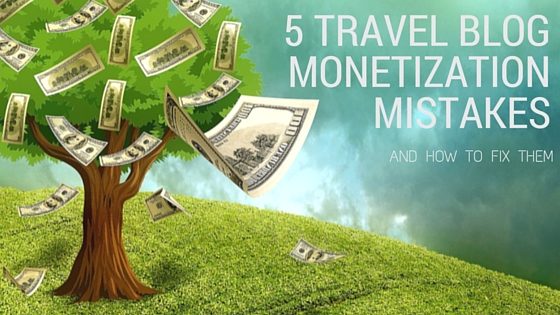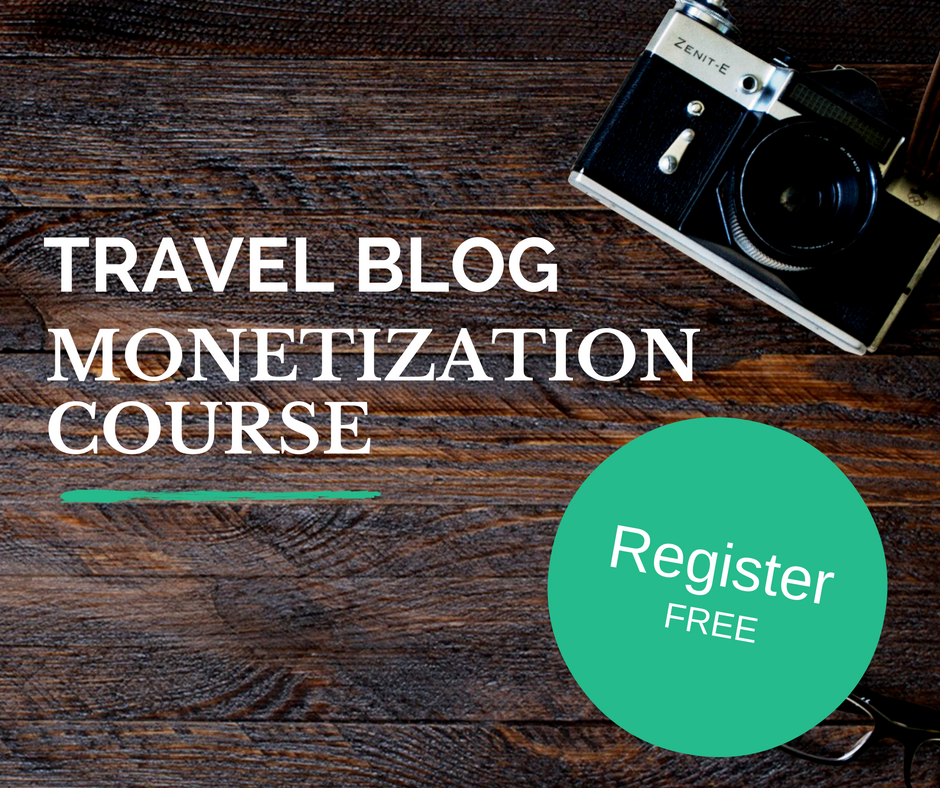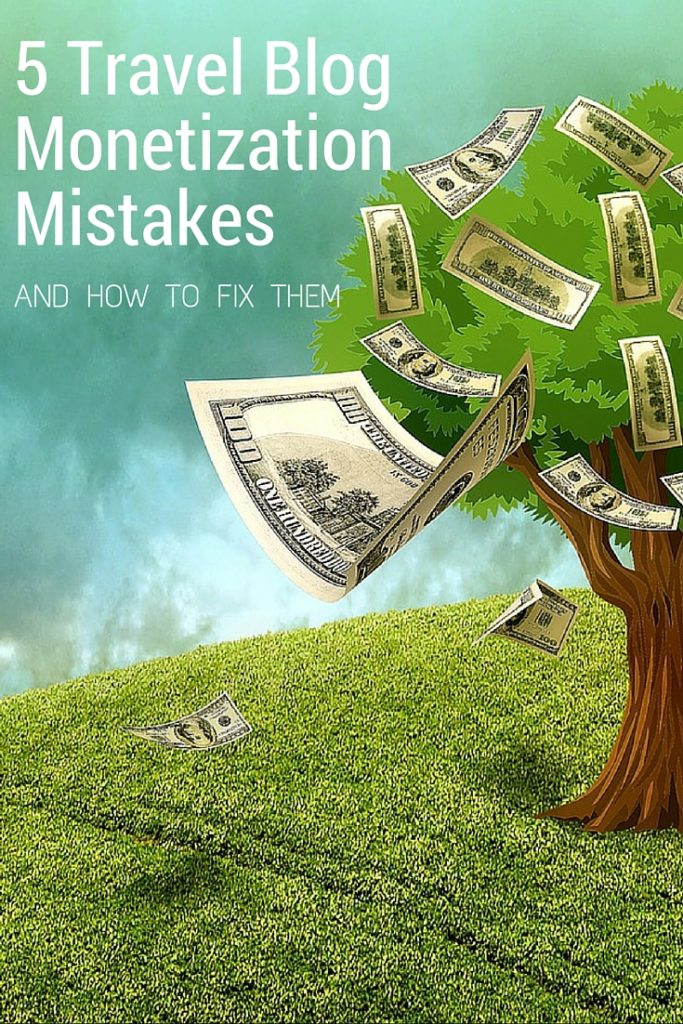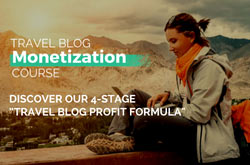If you’ve ever thought to yourself “I’ve put affiliate links in my post, but not made any money” you might be making one or more of these specific, but less obvious, monetization mistakes.
But it goes way beyond just affiliate sales. These mistakes are silently undermining your opportunity to make money.
When you think Travel Blog monetization, you may think of Affiliate sales, or sponsorships.
But there are a number of essential elements that underpin those money making strategies in order for them to be effective.
You may have seen advice like “Content is king – write and they will come”. Or, “Grow a dedicated audience and eventually you’ll be able to make loads of money”.
The idea of audience first, monetize later has some merit. In fact, if you have the motivation to remain unpaid for 4 years waiting until you are “big enough to monetize” it could work… Unless you end up like one top blogger we spoke to, and I’m paraphrasing here, “I’d had an audience for so long who didn’t expect me to sell anything to them, that when I did, I got serious backlash from long term followers. Did they think I could keep blogging around the world forever if I was broke? That I should give them everything for free for the rest of time, while going hungry myself?”
I also consider monetization to be stage two of the process. But stage one is not simply building a blog, it’s building a foundation to monetize.
This should involve setting expectations.
Surprising your audience with paid offers after 4 years of free content can cause issues it seems. But, by gradually integrating monetization on top of a blog that is setup to do so… Not only will you have been gaining readers who fit your long term goal – ie. to turn them into customers – but you’ll have been able to set the expectation from day one that you are not just a free diary of tips. You are in business.
So, for most bloggers who are not yet making money, you may assume that the foundation to monetize which I’m referring to, is your blog… You’d be half right.
The part that no-one seems to make clear is, your blog is the foundation for your high quality content. It’s not the foundation for making money.
That foundation for making money has to be built on stronger concepts than just “Content is king”.
Mistake 1: No Business Plan
Start a travel blog, they said. You’ll make money, they said.
You sit down, make an awesome logo, write loads of great blog posts about all the fantastic countries you have traveled to, maybe even grow a small social media following and then, 6 months later, you’ve made zero dollars.
The vital step you missed. No business plan.
You have good content, you may even have a great brand that really appeals to people who visit your site. But, with no specific plan to make money, you are sat around waiting for that adsense sidebar ad to bring in $3 a month. Or seriously considering diminishing your blog’s reputation by accepting a dubious sponsored post for a $20 fee.
Why does this prevent effective monetization?
Your business plan is actually the foundation of your monetization strategy. A blog is not a business, it’s a content marketing tool. By having great content you gain readers and followers. But without the other step – “the business”, you’ll be waiting a long time before you see money rolling in, if it ever does.
What to do about it?
How do you plan to make money? Just blogging and waiting for someone to offer you tons of cash is a pretty slow and unfocused strategy. It’s also a key reason a lot of bloggers quit – they get bored of making very little each month.
With the benefit of hindsight, I can tell you that the best time to create your business plan is before you even start your blog. But, it’s never too late to re-brand and/or tighten up your focus and direction.
You need to sit down and decide what you will sell. This does not mean being a used car salesman and forcing sales on everyone who drops by. But, businesses make money by selling. Even if not directly to your readers, then to companies who you can work with. Either way, you need to offer a revenue generating sale, or you will never make money.
There are a lot of strategies to monetize, of course. That’s why we have a whole summit in April on implementing proven monetization methods. You need to learn those methods and focus them into a business plan.
And, building a business plan takes more than simply having ideas of what to sell. You also need to think about who to sell to…
Mistake 2: Undefined Target Audience
I see this a lot. You land on a travel blog and… It’s about travel. Now, unless you are TripAdvisor, just being about travel is too vague for the average visitor to “Get You”. Sure, it’s a travel blog. But there are millions of those. Why should your travel blog be of use to them, beyond very quickly reading the article they landed on – and perhaps deciding it’s not for “them”, or just leaving.
In fact, on average, users decide if they are going to stay on a webpage within the first 5 seconds. If the website seems incorrect – as in it does not speak to them as being what they were looking for – they hit the back button and look for an alternative.
Why does this prevent effective monetization?
When you write for “everyone” you actually write for no one. A generic voice does not resonate. That’s a problem.
If you don’t resonate with readers, they don’t trust your opinions. Imagine landing on a page about cruises that has an obvious political bias of “The perfect cruise for Republicans” but you are a democrat. Are you going to take that cruise? Nope.
But, if you are a Republican, you might think, “Yes! I’m going to love this cruise.” You might even feel like the writer of the article is speaking directly to YOU.
This is an extreme example. But the point is, if you know your target audience, you can monetize them because you know something about them. You know how to communicate to them. What’s important to them. And, even better, what sort of things they may want to buy.
What to do about this Mistake?
If you are a small blog, don’t try to be “right” for everyone (Republican pun intended). Instead, go niche. Choose a specific audience and write for them. That audience will love what you do because it’s for them.
It’s better to have a small, dedicated audience who are all into the same stuff and 100% love everything you say, than a broad audience of dis-interested people.
Mistake 3: Your Branding Is Confusing
Don’t think branding is just a logo, or even a company name. Both are a part of your branding, but they are not the only elements. The brand you create needs to immediately convey your purpose, so that visitors to your site “get you”.
If they don’t understand what you do, how do they know it’s relevant to them?
Sure, this can come across in your content too – and should. But as I said before, you have 5 seconds to grab the attention of the average visitor, so it should be on the page.
Why does this prevent effective monetization?
Simply put, the more people who don’t think your site is what they are looking for, the slower your blog will grow. No growth, no money.
What to do about it?
Make sure the look and branding of your site establishes very quickly what you are about. Tying this in with Mistake number 2, it should also convey “who” it is for, as well as what it’s about.
A strong and clear tag line of 3 to 5 words can help clear up confusion if your name is abstract in some way.
Mistake 4: Your Best Content Doesn’t Turn Readers Into Leads
Someone reads your content. Then they leave. You never see them again. Fail.
I call the best content on your website your “Cornerstone content”. It’s your absolute star attraction. The sort of article you spent days laboriously researching and planning to be the best available resource for that topic on the whole internet.
This content is super useful, interesting, perfectly targeted (as discussed above) and solves a problem your target reader has. But it also does something else important… it has a call to action to see you again. To form a relationship.
The article is so effective that readers will want to follow you or join your email list. The content has directed them towards an uncontrollable need to hear from you again – Or maybe buy from you straight away.
Why does this mistake prevent effective monetization?
If you don’t have content that specifically leads visitors to follow you or make a sale, they’ll leave. They may get some useful info from you, for free, but then they’ll realise they got what they needed and don’t need you anymore.
Just like before, once they are gone, you missed an opportunity.
What to do about this mistake?
Create 3 to 4 pieces of amazing content. Stuff that goes way beyond your regular 500 word update or “top 10 in Houston” type article.
As an example, we created a piece of content called 18 Unique Travel Blog Monetization Methods. It was 9,000 words. Shareable and focused on a specific audience. It’s had thousands of views and it’s had a 4.2% subscription rate. 4.2% is actually good for blog content.
Now, you don’t have to write 9,000 words. But your goal is to target a topic and write a killer article that can really help people – and do it better than what is currently available online. Sounds tricky? Actually with some solid research, and sticking to topics you are good at, anyone can do it. We have content we wrote in our first 3 months of blogging that still ranks in the top 20 articles on our oldest blog.
Mistake 5: You Let All Those Leads Slip Away – Or Capture The Wrong Ones
This is the final step, led to from all the above steps. You’ve got the visitor’s attention. You’ve created content that is of great value to them, and you have an underlying business plan of how you are going to make money from those people…
Then something goes wrong. They don’t sign up to your email list and they don’t follow you on social.
What happened?
You didn’t have a relevant call to action. So they left. And/or the call to action you provided was not powerful enough.
Why does this prevent effective monetization?
Leads = money. No leads is bad.
What to do about it?
Here is a typical example of the problem, You write an article “10 best beaches in Indonesia”. At the end of the article, at best you may have a follow me on facebook button, or even a “Get my weekly newsletter” signup box.
Now imagine, that signup was more targeted. You know they want to learn about Indonesia, which means they are likely to be visiting Indonesia. Imagine your signup incentive was “Get my Indonesia’s 5 best secret attractions ebook – for free”. It’s a relevant and targeted promotion that you know visitors to that specific page might want.
You’ll get more leads while simultaneously providing more value to the reader – making you look awesome and an authority on the topic.
Remember, email marketing has far higher engagement than social media – as in social gets about 2% in 2016, Email gets between 10% & 50% on average. So, get people on your email list! Then get them to join you on social after.
TAKE ACTION
I hope this has got you thinking about a target for your business and maybe even an idea for effectively capturing leads.
But how are you going to turn those people into paying customers? What monetization methods are working right now? And how do you implement them effectively?
That’s exactly our focus for the upcoming Travel Blog Monetization Course which will be opening for new members in October 2016.
Learn more about the course – Get the latest info and more content on monetizing your blog.
Love this post? Why not pin it on your favourite blogging Pinterest board?



